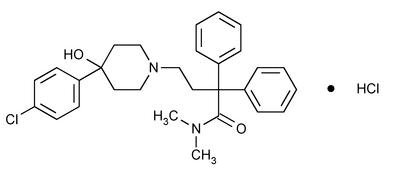Loperamide Hydrochloride
(loe per' a mide hye'' droe klor' ide).
1-Piperidinebutanamide, 4-(4-chlorophenyl)-4-hydroxy-N,N-dimethyl-
4-(p-Chlorophenyl)-4-hydroxy-N,N-dimethyl-
» Loperamide Hydrochloride contains not less than 98.0 percent and not more than 102.0 percent of C29H33ClN2O2·HCl, calculated on the dried basis.
Packaging and storage—
Preserve in well-closed containers.
Identification—
B:
Transfer about 40 mg, accurately weighed, to a 100-mL volumetric flask, dissolve in about 50 mL of isopropyl alcohol, add 10 mL of 0.1 N hydrochloric acid, dilute with isopropyl alcohol to volume, and mix: the UV absorption spectrum between 250 and 300 nm of this solution exhibits maxima and minima at the same wavelengths as that of a similar solution of USP Loperamide Hydrochloride RS, concomitantly measured.
Loss on drying  731
731 —
Dry it in vacuum at 80
—
Dry it in vacuum at 80 for 4 hours: it loses not more than 0.5% of its weight.
for 4 hours: it loses not more than 0.5% of its weight.
Residue on ignition  281
281 :
not more than 0.2%.
:
not more than 0.2%.
Heavy metals, Method II  231
231 :
0.002%.
:
0.002%.
Chromatographic purity—
Prepare a test solution in chloroform containing 10 mg per mL. Apply 10 µL of this solution and 10 µL of a Standard solution of USP Loperamide Hydrochloride RS in chloroform containing 10 mg per mL to a thin-layer chromatographic plate (see Chromatography  621
621 ) coated with a 0.25-mm layer of chromatographic silica gel mixture. Allow the spots to dry, and develop the chromatogram in a solvent system consisting of a mixture of chloroform, methanol, and formic acid (85:10:5) until the solvent front has moved about three-fourths of the length of the plate. Remove the plate from the developing chamber, mark the solvent front, and allow the plate to air-dry. Locate the spots on the plate by exposing it to fumes of iodine: the spot obtained from the test solution corresponds in RF value, color, and intensity to that obtained from the Standard solution, and no secondary spots are observed.
) coated with a 0.25-mm layer of chromatographic silica gel mixture. Allow the spots to dry, and develop the chromatogram in a solvent system consisting of a mixture of chloroform, methanol, and formic acid (85:10:5) until the solvent front has moved about three-fourths of the length of the plate. Remove the plate from the developing chamber, mark the solvent front, and allow the plate to air-dry. Locate the spots on the plate by exposing it to fumes of iodine: the spot obtained from the test solution corresponds in RF value, color, and intensity to that obtained from the Standard solution, and no secondary spots are observed.
Chloride content—
Using about 13 mg, accurately weighed, proceed as directed under Oxygen Flask Combustion  471
471 , using a mixture of 10 mL of 0.02 N sodium hydroxide and 2 drops of 30 percent hydrogen peroxide as the absorbing liquid. When combustion is complete and the combustion gases absorbed, rinse the stopper, sample holder, and inner walls of the flask with 50 mL of isopropyl alcohol. Add 4 mL of 0.1 N nitric acid, and titrate with 0.01 N mercuric nitrate VS, using diphenylcarbazone TS as the indicator. Each mL of 0.01 N mercuric nitrate is equivalent to 0.3545 mg of chlorine: between 13.52% and 14.20% is found.
, using a mixture of 10 mL of 0.02 N sodium hydroxide and 2 drops of 30 percent hydrogen peroxide as the absorbing liquid. When combustion is complete and the combustion gases absorbed, rinse the stopper, sample holder, and inner walls of the flask with 50 mL of isopropyl alcohol. Add 4 mL of 0.1 N nitric acid, and titrate with 0.01 N mercuric nitrate VS, using diphenylcarbazone TS as the indicator. Each mL of 0.01 N mercuric nitrate is equivalent to 0.3545 mg of chlorine: between 13.52% and 14.20% is found.
Assay—
Neutralized acetic acid—
Dissolve 10 mg of  -naphtholbenzein in 100 mL of glacial acetic acid, and titrate with 0.1 N perchloric acid to a green endpoint, disregarding the amount of titrant consumed.
-naphtholbenzein in 100 mL of glacial acetic acid, and titrate with 0.1 N perchloric acid to a green endpoint, disregarding the amount of titrant consumed.
Procedure—
Dissolve about 375 mg, accurately weighed, of Loperamide Hydrochloride in 25 mL of Neutralized acetic acid. Add 10 mL of mercuric acetate solution (prepared by dissolving 1 g of mercuric acetate in 33 mL of Neutralized acetic acid) and titrate with 0.1 N perchloric acid VS to the original green color of the Neutralized acetic acid. Each mL of 0.1 N perchloric acid is equivalent to 51.35 mg of C29H33ClN2O2·HCl.
Auxiliary Information—
Please check for your question in the FAQs before contacting USP.
| Topic/Question | Contact | Expert Committee |
|---|---|---|
| Monograph | Elena Gonikberg, Ph.D.
Principal Scientific Liaison 1-301-816-8251 |
(SM32010) Monographs - Small Molecules 3 |
| Reference Standards | RS Technical Services 1-301-816-8129 rstech@usp.org |
USP35–NF30 Page 3703

